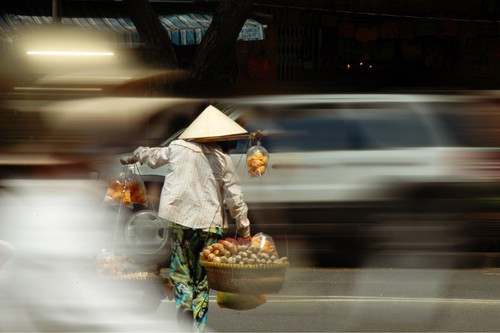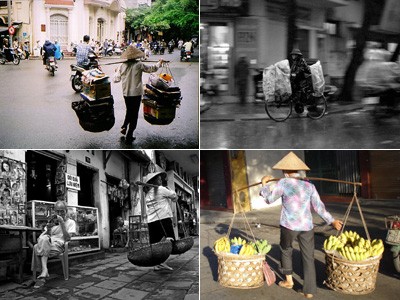
Let’s take a break from “street food” and consider what the Vietnamese term “gánh hàng rong,” which means “street hawker,” really means.

Prosperity, rural street vendors, and shaky light loads will instinctively offer us a sense of tranquility and peace from the heart to the strange in the middle of the hustle and bustle of city life.
The word “hawker” only means “a person who travels around selling goods, typically advertising them by shouting” to me. I have no idea what is implied or what is written in between the lines. If we interpret “gánh hàng rong” using Google interpret, it humorously means “burden vendors” but actually implies burden or a hefty weight.
“Gánh hàng rong” is a set of three words in Vietnamese, and each word in the phrase has a distinct meaning.

Gánh is a traditional carrying device that consists of two baskets that are hung at opposite ends and a bamboo pole that is placed on the shoulder. The burden on each basket must be equal to maintain balance.
Hàng: products
Rong: as I surmise, it may be derived from “rong ruổi”: to move about, to converse with others.
Gánh hàng rong: an ancient instrument for carrying stuff while moving around!

The term “gánh hàng rong” has been “humanized” to refer to someone who is hawking items on the streets while walking and screaming.
Vietnamese speakers frequently relate the word “gánh hàng rong” with an uncertain future, particularly a woman’s or mother’s future.

The items they carry usually aren’t a huge load, yet they must endure a difficult existence and provide for their families and children.
Gánh hàng rong is still connected to the tradition that might disappear in the future, along with the stereotype of the hard-working lady raising her family.
Our memories of childhood are still strongly connected to the phrase “ganh hàng rong”!
We used to see them and buy things from them, but do we recall their faces or are we familiar with their origins? Typically, no!




